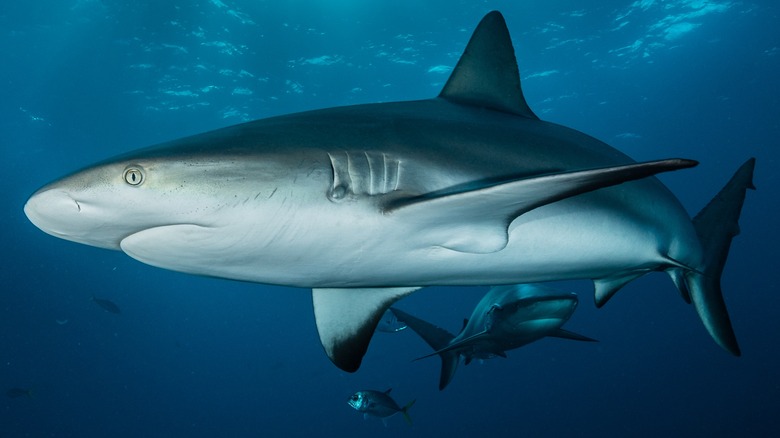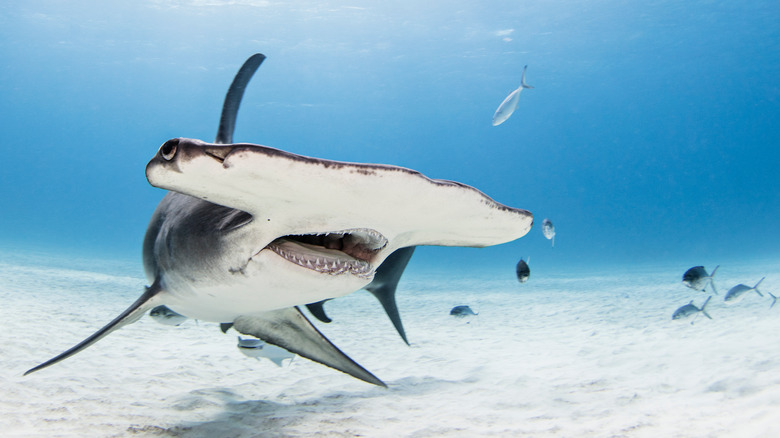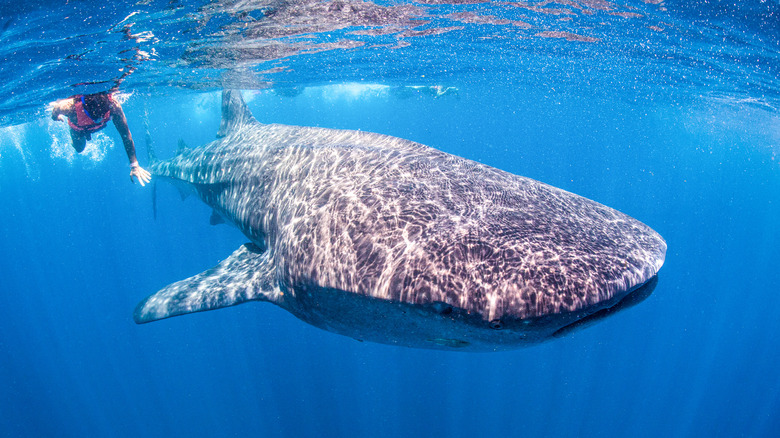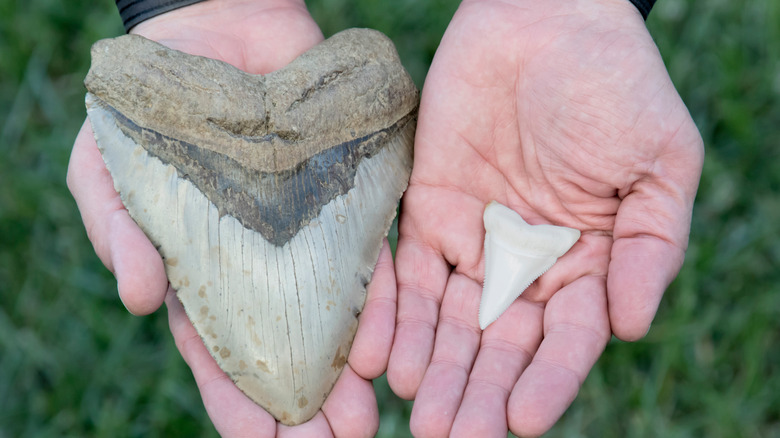Sharks Have Been Around For Much Longer Than You Thought
Update: The original version of this article stated that the blue whale was the biggest shark in the sea; we have corrected this to state that the blue whale is the biggest animal in the sea.
Though shark attacks regularly pop up on the news, these marine predators are actually quite restrained around human swimmers: They don't actually want to chomp down on homo sapiens (via National Geographic). Instead, sharks prefer a diet of fish and seals. Other fun facts about sharks: They have no bones (via NOAA Fisheries), they can be pregnant for years (via BestLife), and, oh, yeah — sharks are some of the oldest species on the planet.
Sharks have been around since the late Ordovician period, around 450 million years ago, according to the U.K.'s National History Museum. That puts them on the scene not long after the first land plants, which evolved around 500 million years ago (via Science), but well before the dinosaurs, which didn't evolve until around 250 million years ago, according to CNN.
Where are humans in all this? Our earliest ancestors didn't evolve until around 6 million years ago, according to Universe Today, meaning we've been around about 1/75 of the time of sharks.
Sharks' diverse traits and habitats
There are many species of sharks. They can range in size from less than a foot long to over 50 feet long, and they live in a variety of habitats (via National Geographic). Their true uniting features are their long body shapes, their many triangular teeth, and their cartilage skeletons (via Britannica). There may be as many as 1,000 species of sharks and rays in the world, according to the World Wildlife Fund.
Among the most famous species includes the whale shark, which is the biggest shark in the world at around 65 feet long and which subsists on plankton (via the World Wildlife Fund) and the great white shark, which weighs up to two-and-a-half tons and is the shark most commonly associated with attacks on people, despite its lack of taste for human flesh (via National Geographic). Around 10 people die due to shark attacks each year around the world, according to the Australian Institute of Marine Science.
But before you judge sharks too much, note that as many as 100 million sharks are killed each year by human fishing, according to National Geographic. Since 1970, shark populations have shrunk by over 70%, according to CNN.
The origins of sharks
When sharks first appeared 450 million years ago, they looked pretty different than they do today (via The National History Museum). There weren't great whites or Megalodons swimming around in the Ordovician oceans. Instead, the first sharks were smaller and may have lacked teeth entirely. Later, they developed spiny outgrowths and the eventual characteristic teeth, but in many ways still appeared more like fish than sharks.
It wasn't until 360 million years ago that the Carboniferous Period began and shark populations truly exploded. Also called the golden age of sharks, the Carboniferous Period was host to a variety of new shark species including the falcatus, or unicorn shark which, as the name suggests, had a narwhal-like horn (via Sharksider). At least 45 families of sharks existed during the Carboniferous era, according to the Smithsonian, but when there was a mass extinction event 250 million years ago, most died out. It's not yet known what caused this extinction event, called the Permian-Triassic extinction, but it wiped out almost all plant and animal life on Earth (via National Geographic).
Sharks have survived five mass extinctions
Since the first sharks came on the scene, there have been five separate mass extinction events, according to CNN. This includes the famous Cretaceous-Paleogene extinction event that wiped out the dinosaurs, as well as the Ordovician Extinction, the Late Devonian Extinction, the Permian-Triassic extinction, and the Triassic-Jurassic extinction (via the American Museum of Natural History).
In some of these extinctions, only a few shark species survived, and only a couple of shark species enduring the Permian-Triassic extinction, according to The National History Museum. However, enough survived that the group as a whole was able to make it, and around 200 million years ago, modern sharks like the frilled shark began to arise, according to Micronesian Conservation. Later, around 60 million years ago, the massive Megalodon shark evolved, and for a while was the largest predator in the ocean, according to Sharksider, though around 2.5 million years ago it went extinct, leaving the blue whale the biggest animal in the seas.



